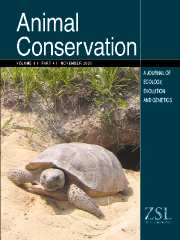Crossref Citations
This article has been cited by the following publications. This list is generated based on data provided by
Crossref.
Beckmann, Jon P.
and
Berger, Joel
2003.
Rapid ecological and behavioural changes in carnivores: the responses of black bears (Ursus americanus) to altered food.
Journal of Zoology,
Vol. 261,
Issue. 2,
p.
207.
Fernández, Néstor
Delibes, Miguel
Palomares, Francisco
and
Mladenoff, David J.
2003.
IDENTIFYING BREEDING HABITAT FOR THE IBERIAN LYNX: INFERENCES FROM A FINE‐SCALE SPATIAL ANALYSIS.
Ecological Applications,
Vol. 13,
Issue. 5,
p.
1310.
Revilla, Eloy
Wiegand, Thorsten
Palomares, Francisco
Ferreras, Pablo
and
Delibes, Miguel
2004.
Effects of Matrix Heterogeneity on Animal Dispersal: From Individual Behavior to Metapopulation‐Level Parameters.
The American Naturalist,
Vol. 164,
Issue. 5,
p.
E130.
2004.
Ecology, Genetics and Evolution of Metapopulations.
p.
599.
Rodrı́guez, Alejandro
and
Delibes, Miguel
2004.
Patterns and causes of non-natural mortality in the Iberian lynx during a 40-year period of range contraction.
Biological Conservation,
Vol. 118,
Issue. 2,
p.
151.
KRAMER‐SCHADT, STEPHANIE
REVILLA, ELOY
WIEGAND, THORSTEN
and
BREITENMOSER, URS
2004.
Fragmented landscapes, road mortality and patch connectivity: modelling influences on the dispersal of Eurasian lynx.
Journal of Applied Ecology,
Vol. 41,
Issue. 4,
p.
711.
Kramer-Schadt, Stephanie
Revilla, Eloy
and
Wiegand, Thorsten
2005.
Lynx reintroductions in fragmented landscapes of Germany: Projects with a future or misunderstood wildlife conservation?.
Biological Conservation,
Vol. 125,
Issue. 2,
p.
169.
SCHROTT, GREGORY R.
WITH, KIMBERLY A.
and
KING, ANTHONY W.
2005.
Demographic Limitations of the Ability of Habitat Restoration to Rescue Declining Populations.
Conservation Biology,
Vol. 19,
Issue. 4,
p.
1181.
Crisci, Jorge V.
Sala, Osvaldo E.
Katinas, Liliana
and
Posadas, Paula
2006.
Bridging historical and ecological approaches in biogeography.
Australian Systematic Botany,
Vol. 19,
Issue. 1,
p.
1.
Fernández, Néstor
Delibes, Miguel
and
Palomares, Francisco
2006.
Landscape Evaluation In Conservation: Molecular Sampling And Habitat Modeling For The Iberian Lynx.
Ecological Applications,
Vol. 16,
Issue. 3,
p.
1037.
HOWE, ERIC J.
OBBARD, MARTYN E.
and
SCHAEFER, JAMES A.
2007.
Extirpation Risk of an Isolated Black Bear Population Under Different Management Scenarios.
The Journal of Wildlife Management,
Vol. 71,
Issue. 2,
p.
603.
Revilla, Eloy
and
Wiegand, Thorsten
2008.
Individual movement behavior, matrix heterogeneity, and the dynamics of spatially structured populations.
Proceedings of the National Academy of Sciences,
Vol. 105,
Issue. 49,
p.
19120.
Kolowski, Joseph M.
and
Nielsen, Clayton K.
2008.
Using Penrose distance to identify potential risk of wildlife–vehicle collisions.
Biological Conservation,
Vol. 141,
Issue. 4,
p.
1119.
Grilo, Clara
Bissonette, John A.
and
Santos-Reis, Margarida
2009.
Spatial–temporal patterns in Mediterranean carnivore road casualties: Consequences for mitigation.
Biological Conservation,
Vol. 142,
Issue. 2,
p.
301.
García-Bocanegra, I.
Dubey, J.P.
Martínez, F.
Vargas, A.
Cabezón, O.
Zorrilla, I.
Arenas, A.
and
Almería, S.
2010.
Factors affecting seroprevalence of Toxoplasma gondii in the endangered Iberian lynx (Lynx pardinus).
Veterinary Parasitology,
Vol. 167,
Issue. 1,
p.
36.
Marucco, F.
and
McIntire, E. J. B.
2010.
Predicting spatio‐temporal recolonization of large carnivore populations and livestock depredation risk: wolves in the Italian Alps.
Journal of Applied Ecology,
Vol. 47,
Issue. 4,
p.
789.
García, Ignacio
Napp, Sebastián
Zorrilla, Irene
Vargas, Astrid
Pastor, Josep
Muñoz, Álvaro
and
Martínez, Fernando
2010.
Determination of serum biochemical reference intervals for the Iberian lynx (Lynx pardinus).
The Veterinary Journal,
Vol. 183,
Issue. 2,
p.
201.
Ferreras, Pablo
Travaini, Alejandro
Cristina Zapata, S.
and
Delibes, Miguel
2011.
Short-term responses of mammalian carnivores to a sudden collapse of rabbits in Mediterranean Spain.
Basic and Applied Ecology,
Vol. 12,
Issue. 2,
p.
116.
Shibata, Jun‐ya
Karube, Zin'ichi
Oishi, Mamiko
Yamaguchi, Mana
Goda, Yukiko
and
Okuda, Noboru
2011.
Physical structure of habitat network differently affects migration patterns of native and invasive fishes in Lake Biwa and its tributary lagoons: stable isotope approach.
Population Ecology,
Vol. 53,
Issue. 1,
p.
143.
Rhodes, Jonathan R.
Ng, Chooi Fei
de Villiers, Deidré L.
Preece, Harriet J.
McAlpine, Clive A.
and
Possingham, Hugh P.
2011.
Using integrated population modelling to quantify the implications of multiple threatening processes for a rapidly declining population.
Biological Conservation,
Vol. 144,
Issue. 3,
p.
1081.


